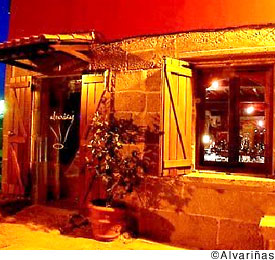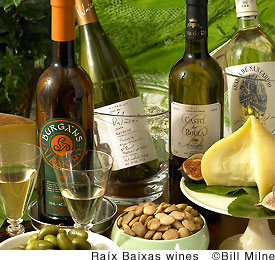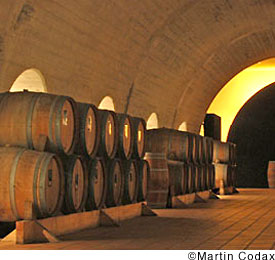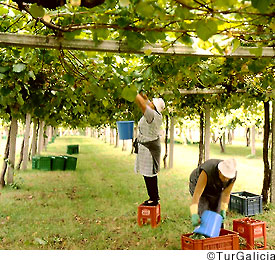Albariño
The finest white wine of Spain
by Eunice Fried We inched our way in the dark along a narrow stone path in the old Spanish fishing village of Combarro, past small, silent stone houses, a vest pocket bar where men sat quietly playing cards, down a few uneven steps, a right turn, up a few steps, then a left turn. It was late, it was chilly, and as we neared the end of the village, I could hear waves lapping against the seawall. Where was Marisol leading us? What could be here, at the edge of this little village? And then, when there was nowhere further to go, as if a mirage, it appeared, built into the rock wall at the water's front. It was 10:30 pm when we entered Alvariñas, a shockingly handsome, formal restaurant, and until two in the morning, we dined on the gastronomic wonders of Galicia.
We inched our way in the dark along a narrow stone path in the old Spanish fishing village of Combarro, past small, silent stone houses, a vest pocket bar where men sat quietly playing cards, down a few uneven steps, a right turn, up a few steps, then a left turn. It was late, it was chilly, and as we neared the end of the village, I could hear waves lapping against the seawall. Where was Marisol leading us? What could be here, at the edge of this little village? And then, when there was nowhere further to go, as if a mirage, it appeared, built into the rock wall at the water's front. It was 10:30 pm when we entered Alvariñas, a shockingly handsome, formal restaurant, and until two in the morning, we dined on the gastronomic wonders of Galicia.
If finding Alvariñas, the restaurant, in an unlikely spot was a splendid surprise, it was second to discovering Albariño, the wine of Rías Baixas, the most important wine of Galicia and the finest white wine of Spain.
Galicia is the far northwestern corner of Spain, bordered on the west by the Atlantic Ocean, on the north by the Bay of Biscay and on the south by Portugal. So much of what one associates with Spain is absent in Galicia. There are no Moorish castles, no flamenco posters, no bull rings. Here, the land is blanketed in green rather than in the beige and taupe of much of the Spanish countryside. This is a land settled by the Celts in the 6th century, B.C. before they moved on to Ireland, and in fact, there were moments, surrounded by verdant hillsides and listening to Galician folk music on a gaitas, an instrument eerily similar to the bagpipe, when I felt I could be in Ireland. After the Celts, the Romans, Visigoths and others came to Galicia before it was made part of the Kingdom of Asturia. In the 10th century A.D., legend has it, St. James's body was discovered here. A cult grew and over the next two centuries, a cathedral was built and the tradition of making a pilgrimage to the Santiago de Compostela cathedral began. It continues today.  Galicia is where rías, broad inlets, run from the Atlantic deep into the countryside. It is the southern end of these rías, known as Rías Baixas (ree-ahs by-shuss) that is the home of Albariño. It is the name both of the grape and the wine made from it, and while its history goes back centuries, it is only since the 1980's that it has evolved into Spain's most acclaimed white wine.
Galicia is where rías, broad inlets, run from the Atlantic deep into the countryside. It is the southern end of these rías, known as Rías Baixas (ree-ahs by-shuss) that is the home of Albariño. It is the name both of the grape and the wine made from it, and while its history goes back centuries, it is only since the 1980's that it has evolved into Spain's most acclaimed white wine.
In Rías Baixas, the climate is mild with ample sunshine. It is also a region that receives an abundance of rain which is why most of the vines are grown on the pergola system, training the vines to grow up and across six foot high granite stakes, forming a trellis and keeping the grapes off the damp ground. Even in this relatively small wine region of 6,900 acres, there are sub-regions, running from those closest to the ocean--Val do Salnés, for example--and thus wetter and cooler, to those more inland, such as Condado do Tea, farthest from the ocean and somewhat warmer and less damp. Other sub-regions include O Rosal, Soutomaior and Ribeira do Ulla. In all there are 192 wineries in Rías Baixas, up from a mere 60 in 1990.
Albariño, the wine, is generally dry with fruit flavors that vary from lime and pineapple to pear, peach, melon, apple and apricot; sometimes with a floral note added, always with a bracing acidity, a mineral-like cleanliness and freshness. While they all carry a family resemblance, some are slightly rounder and fleshier; others, lighter-bodied and tangy; and each carries an individual personality.
If I were to choose one as the quintessential Albariño, it would be Pazo de Señoráns with its supple body, aromatic blend of lemon, lime and peach and delicious taste. Its upper class sibling is the complex, rich Rías Baixas Pazo de Señoráns Selección de Añada; made from the 45 year old vines of a single vineyard, it is one of the region's most outstanding wines. Pazo de Señoráns, housed in a fourteenth century estate, is owned by Marisol Bueno and Javier Mareque; Marisol was one of the people most responsible for helping establish Albariño as an official Spanish wine producing region and setting the wine on its trajectory to international fame.  Marqués de Vizhoja Torre La Moreira, another single vineyard Albariño, is a wine that captures the grape's character beautifully with its good acidity and evocative fruit flavors. The Peláez family has been making wine for 50 years. "Forty years ago," Jorge, the son, said,"my father was the first to put the name of the grape, Albariño, on the wine label." Martín Códax, a cooperative of 285 members that takes its name from a thirteenth century Galician troubadour, offers an Albariño that is minerally with a burst of peach, melon and fresh green apple. Condes de Albarei is another cooperative, this one with 340 members; among the wines it produces is the appealing Albariño Condes de Albarei that displays a vibrancy and a beautiful balance between fruit and acidity. The cooperative also bottles a rich, ripe golden yellow Albariño from 40 year old vines that it has named Enxebre, a Galician word that means "homemade."
Marqués de Vizhoja Torre La Moreira, another single vineyard Albariño, is a wine that captures the grape's character beautifully with its good acidity and evocative fruit flavors. The Peláez family has been making wine for 50 years. "Forty years ago," Jorge, the son, said,"my father was the first to put the name of the grape, Albariño, on the wine label." Martín Códax, a cooperative of 285 members that takes its name from a thirteenth century Galician troubadour, offers an Albariño that is minerally with a burst of peach, melon and fresh green apple. Condes de Albarei is another cooperative, this one with 340 members; among the wines it produces is the appealing Albariño Condes de Albarei that displays a vibrancy and a beautiful balance between fruit and acidity. The cooperative also bottles a rich, ripe golden yellow Albariño from 40 year old vines that it has named Enxebre, a Galician word that means "homemade."
For years, the family that owns Pazo Pondal, made wine only for its own consumption. Then, in 1998, it became a commercial entity opening with a new, modern winery. One taste of their Albariño, and I agreed: this wine should be shared with others. Crisp, complex and harmonious, it offers a fragrant basketful of fruit from peach and pineapple to apple and apricot as well as floral overtones.
At Bodegas Pazo de Barrantes, another family-owned winery, winemaker Pilar Jiménez poured its Albariño--a pale-shaded, focused, minerally wine brimming with fresh fruits. How does she create such a pretty wine? "I keep winemaking simple," she said, "I respect the vine; I consider it a living being."
Bodega Valdamor means "valley of love," and its wines could be love at first sip. Its Albariño is crisp, sprightly, with a medley of fruit and flowers in the aroma. Its Vintage Selection is complex, succulent with a bounty of pear and pineapple.  From Bodegas La Val, a family-owned winery, we have its bright, flavorful La Val Albariño hinting of grapefruit and other citrus fruits; and its excellent Finca de Arantei Albariño--intense, golden yellow, mineral-ladened, rich in ripe fruit flavors and as smooth as fine silk. From Coto de Xiabre, another family-owned winery, there is Maior de Mendoza, a vibrant, highly aromatic Albariño that recalls pear, peach and apple. And from Pazo San Mauro, which is part of a larger winery group, winemaker Cristina Mantilla offers a racy Albariño bursting with citrus fruits--especially fresh lemony flavors--and a body that is all silk and satin.
From Bodegas La Val, a family-owned winery, we have its bright, flavorful La Val Albariño hinting of grapefruit and other citrus fruits; and its excellent Finca de Arantei Albariño--intense, golden yellow, mineral-ladened, rich in ripe fruit flavors and as smooth as fine silk. From Coto de Xiabre, another family-owned winery, there is Maior de Mendoza, a vibrant, highly aromatic Albariño that recalls pear, peach and apple. And from Pazo San Mauro, which is part of a larger winery group, winemaker Cristina Mantilla offers a racy Albariño bursting with citrus fruits--especially fresh lemony flavors--and a body that is all silk and satin.
Every Albariño seems born to be a companion to the foods of Galicia. At our late night dinner at Restaurant Albariñas, Albariño mingled comfortably with empanadas, asparagus wrapped around octopus, smoked salmon twisted around cream cheese, with shrimp, crab, lobster, sardines and langoustines. It was a natural with hake, its flavors heightened by oregano and paprika; and even with veal cheeks in a red wine reduction. In other restaurants throughout Rías Baixas, Albariño was equally accommodating with scallops en brochette; grilled monkfish, sea bass, a pork dish served on a bed of kale, with all of Galicia's seafood, from clams, mussels and oysters to cuttlefish, trout and lamprey. And they do equally well with light meat dishes.
But Albariño is not limited to Galician cuisine. It goes naturally with all seafood, with pork, chicken and veal dishes. It goes well with Chinese, Thai and other Asian cuisines and with Indian dishes. And it is a lovely drink unto itself.
Albariño is a wine to drink when you buy it; it needs no further aging. It is a wine that rarely costs over $20 and usually less. The world is just beginning to discover Albariño. Perhaps you should too.

